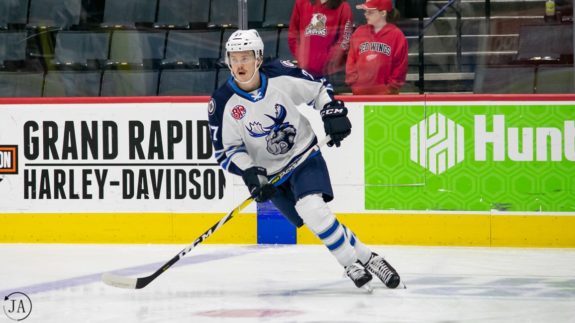The Winnipeg Jets’ bottom-six took a hit during Free Agent Frenzy on Monday as forward Brandon Tanev signed a six-year deal with the Pittsburgh Penguins.
However, it’s not as big a hit as a large portion of the Jets’ fanbase are making it out to be. There’s someone already within the organization who may very well be able to perform just as well — if not better — in his spot.
Indispensable or Replaceable?
There’s no doubt the Jets would have loved to retain the services of speedy winger Tanev, who they plucked from Providence College in 2016 and paid just $1.15 million last season. However, a combination of the team’s cap crunch and Tanev’s banner year — a career-high 14 goals and 15 assists — meant they couldn’t afford to give him anywhere close to the $3.5 million AAV the Penguins did.

Even though Tanev leaving town was probable for weeks prior to Tuesday, it did nothing to ease the anger of those who consider losing the 27-year-old nothing short of disastrous.
However, the Jets’ fanbase as a whole (author included, at times) is guilty of overvaluing Tanev and are reacting disproportionately to his departure.
The reason Tanev was a fan favourite in Winnipeg is because he was exactly the type of player a generally blue-collar market identifies with. He was willing to sacrifice his body by stepping in front of any shot, became the Jets’ franchise leader in hits by throwing his frame at everything at moved, and gave nothing less than full effort during every second of every shift in his 195-game Jets career.

In short, he was a lunch-bucket player beloved by a bunch of lunch-bucket fans. Not a superstar, but a hard-working guy who parlayed that hard work into a big new deal in the Steel City. No disrespect to the man at all.
Tanev Was Terrific…On TLC
However, the idea Tanev would be the difference between the Jets making the playoffs or not in 2019-20 doesn’t pass muster. He was never a player who drove possession on his own.
Tanev needed specific line mates in Winnipeg to excel. When paired with Adam Lowry and Andrew Copp as part of the “TLC” trio that was united and broken up several times, he was terrific, possession-wise.
Related: Multi-Talented Tanev Boosting Jets’ Third Line
Away from those two, however, his numbers were a lot uglier. Scott Billeck summed it up well with a recent Twitter thread.
That’s why the Penguins’ deal is risky. There’s no guarantee — or any indication, really — Tanev will be able to do what he did with Lowry and Copp with anyone else.
“Tanev is a very effective fourth liner. But he’s a fourth liner. Never give fourth liners term,” advanced stats guru Andrew Berkshire tweeted in the wake of the deal.
Appleton Poised to Take Tanev’s Place
The Jets may very well have Tanev’s replacement already revved up and ready to take the open slot and huge opportunity Tanev’s departure has left.
“Tanev playing without Lowry (and) Copp is a far less effective player, and one that is easily replaceable,” Billeck continued in the same thread. “I see no drop off with Mason Appleton in that role.”
Could Appleton, indeed, slide seamlessly into the Jets’ bottom six come fall? There’s certainly a compelling case to be made for the 23-year-old.

Appleton can play centre or wing. While he doesn’t bring the same skills to the table as Tanev (Appleton won’t crash and bang nor will he be a penalty kill option) he is a skilled player who has more pure offensive ability.
In a few years, pundits could be considering the Green Bay product as one of the greatest steals of the 2015 NHL Entry Draft (he was chosen in the sixth round of the Jets’ best draft ever) given the offensive awareness, strong puck handling skills, and ability to turn a game on its head with a timely tally he’s shown.
Related: Jets NHL Draft Days Ranked
Many, this author included, thought he was ready to make the jump to the Jets after his terrific 2016-17 rookie campaign with the Manitoba Moose that saw him tally 66 points and voted the AHL’s Outstanding Rookie.
In 2018-19, Appleton made his NHL debut and suited up for 35 NHL games between late November and late February, tallying three goals and seven assists on a fourth line that proved capable of holding the puck in the offensive zone, applying dogged pressure at five-on-five, and chipping in offensively. While he showed well, he was sent down after Kevin Hayes joined the club at the trade deadline, simply because Appleton didn’t have to clear waivers.

Appleton’s possession numbers, albeit in a small sample size, were nearly identical to Tanev’s in his first NHL stint. He also comes cheap — he’s on the last year of his entry-level contract — and having inexpensive players who can contribute will be of utmost importance for the Jets going forward given their need to sign Patrik Laine and Kyle Connor to lucrative new deals this summer.
Appleton Has the Inside Track
Appleton should be given every opportunity come September to shoulder the increased responsibility and new role.
He’s paid his dues in the AHL and has come along nicely because of it, and is head-and-shoulders above Kristian Vesalainen, whose choice to go on a European excursion last season rather than stick around in North America wasted a potential year of his development.

Appleton looked good with fourth-line possession-driver Andrew Copp (on the line mentioned in the last section) and the two would only develop further chemistry over a full season together.
An Appleton/Copp pairing may not happen — there’s plenty of conjecture (as always) in Winnipeg on whether Bryan Little will be the second-line centre next season or if Copp could challenge for the job. Appleton is not much of a checker, so he’d be unlikely to play with Lowry on the third line. Ideally, though, Appleton’s success won’t be contingent on his linemates like Tanev’s was. If that proves to be the case, it’d give them more options.
While the gap left by Tanev seems, at first glance, as big as a bus, it can likely be nicely filled by a 6-foot-2, 190-pound Wisconsinite.